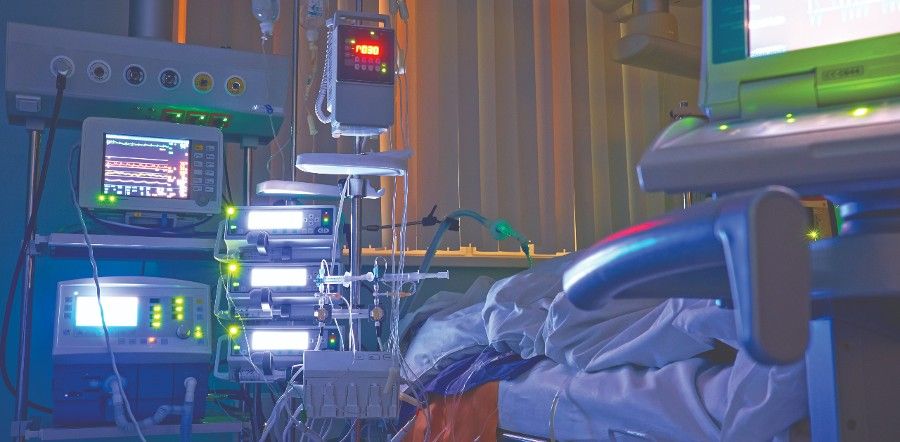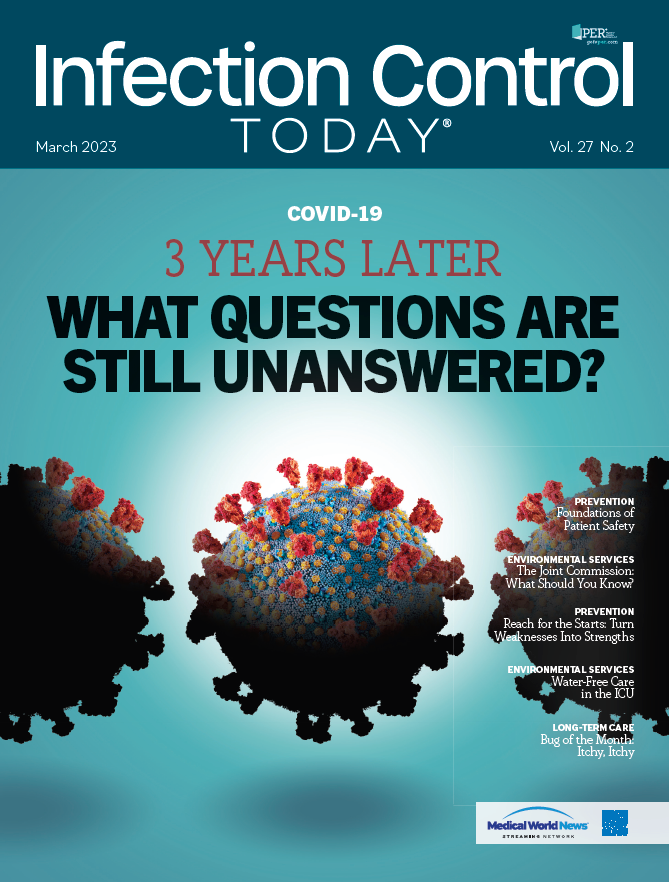Stop Infections in Their Tracks: Water-Free Care in the ICU
The proximity of sinks in patient zones may increase a patient’s risk of acquiring gram-negative hospital-acquired infections.
ICU room
(Adobe Stock 252813850)

Patient rooms with sink drains have a higher load of bacterial pathogens, study results have shown.1 Sinks can be a reservoir for gram-negative bacteria (GNB) and facilitate colonization and infection of patients, especially in the intensive care unit (ICU).1 Patients in the ICU are at high risk for health care–acquired infections (HAIs) because of “the high prevalence of invasive procedures and devices and their induced immunosuppression, comorbidities, frailty, and increased age.”2 Implementing a water-free environment in the ICU can be an innovative way for hospitals to remove threatening microbial exposure from splashes, aerosols, and contaminated water.
Infection Control Today® (ICT®) spoke with Joost Hopman, MD, PhD, DTMH, the medical director and consulting microbiologist at Radboud University Medical Center in Nijmegen, Netherlands. Hopman conducted a 2-year pre/post- quasi-experimental study to evaluate the effect of removing sinks and introducing water-free patient care in the ICU of a large tertiary care medical center in the Netherlands.3 The ICU in the study had 34 operational single-patient rooms. Staff members sought to eradicate multidrug-resistant gram-negative bacteria in the immediate patient environment after ICU sinks tested positive for Enterobacter cloacae extended-spectrum β-lactamase- producing organisms.
Hopman said, “We had this in mind: ‘We have a similar problem, we have a sink with multidrug resistance.’ If we remove the same, the outbreaks will be stopped….It was the most sustainable way of dealing with it. We tried cleaning and disinfection, putting disinfectants in the drain, everything, but nothing worked. Now years later, we have the experimental settings that proved biofilms will grow very fast. Studies showed us that it doesn’t matter how much disinfectant you put into it; they will always grow back. Bacteria are much more resistant and resilient than we can ever come up with solutions [to combat]. To me, the only sustainable solution is to remove this source. And when we did this, it was very radical. Nobody believed this could be the way forward [because] you always need water and soap.”
How can sinks be implicated as a reservoir for gram-negative bacteria? First, because the water coming into the sink is not sterile, it can contain gram-negative bacteria such as Pseudomonas aeruginosa and Legionella. Using of tap water in medical care can be a potential risk for exposure.4 Tap water can be used as a diluent for solutions, as a water source for medical instruments and equipment, and for performing hand washing by health care workers. Contaminated water can also invade the patient’s zone through the backsplash and aerosols created by the water’s pressure or dripping. Surfaces near sinks can be unknowingly contaminated, and staff may use these areas to prepare medicine or patient equipment. Although unintentional, this contaminated water can cause infections in patients who are immunocompromised or susceptible.
Running water in a sink
(Adobe Stock 388932211)

Next, sinks can create a suitable environment for bacteria to proliferate and create biofilms. In sinks, biofilms prefer to grow in areas such as the U-shaped bend in pipes, Hopman told ICT®. Removing these biofilms is extremely difficult and can involve taking apart structures in the sink and plumbing and replacing components.
Infection control and prevention is “always a multimodal intervention,” Hopman said. “Several elements must be in place to prevent our patients from becoming colonized and infected. And this holds true in the entire facility, the ICU included. If you want to prevent patients in the ICU from becoming colonized with gram negatives, you have to do hand hygiene; you have to do cleaning and disinfection your environment; you have to have your protocols; you have to have the prevention of bloodstream infection programs in place. However, if you have a continuous source of multidrug resistance next to your patient, no matter what you do, it will remain a risk. We tried to analyze for what purposes the sinks were used in our ICU. And this is something we had to do prior to removing the sinks out of the rooms.”
Contaminated water can also invade the patient’s zone through the backsplash and aerosols created by the water’s pressure or dripping. Surfaces near sinks can be unknowingly contaminated, and staff may use these areas to prepare medicine or patient equipment.
Hopman continued, “It’s a complicated onboarding process….And this is something we put a lot of emphasis on. It’s something we did together with the intensive care doctors and intensive care nurses in conjunction with the infection prevention and control teams. You cannot do this on your own. It has to be a team effort.”
Between May and August 2014, Hopman and his team removed all the sinks in all ICU patient rooms. A water-free method was introduced, meaning that all patient care-related activities normally involving tap water were adapted to a water-free alternative. Adapted activities included medication preparation, cannula care, hair washing, shaving, and dental care. Participants included all patients 18 years and older admitted to the ICU for at least 48 hours during the study period.3
The study results concluded that removing sinks from patient rooms and introducing water-free patient care was associated with a significant reduction of patient colonization with gram-negative bacteria. This reduction in colonization was more pronounced in patients with a longer ICU length of stay.3 The results showed from a 1.22-fold reduction during a greater than or equal to 2 days’ stay to a 3.6-fold for greater than or equal to 14 days in the ICU.3
This study demonstrated an avant-garde approach to the increasing threat of gram-negative bacteria in health care settings, primarily from water sources. There has been a move toward water-free patient care in various hospital practices. Waterless hand rubs have become the agents of choice for hand hygiene and are universally used throughout health care facilities in the United States.5 Waterless bathing and oral care are also preferred in specific patient populations, such as ICU patients. Many products are available for use, such as bathing wipes, dry shampoo, rinse-free shower caps, oral swabs, and more. Hospital water supply can be a source of nosocomial infections, and facilities should have an established water management program and policy to manage the risks associated with the water system. Water-free care is an upcoming movement for ICUs with evident benefits for patients and staff.
References
- Pirzadian J, Souhoka T, Herweijer M. Impact of sink design on bacterial transmission from hospital sink drains to the surrounding sink environment tested using a fluorescent marker. J Hosp Infect. 2022;127:39-43. doi:10.1016/j.jhin.2022.04.017.
- Blot S, Ruppé E, Harbarth S, et al. Healthcare-associated infections in adult intensive care unit patients: changes in epidemiology, diagnosis, prevention and contributions of new technologies. Intensive Crit Care Nurs. 2022;70:103227. doi:10.1016/j.iccn.2022.103227
- Hopman J, Tostmann A, Wertheim H, et al. Reduced rate of intensive care unit acquired gram-negative bacilli after removal of sinks and introduction of ‘water-free’ patient care. Antimicrob Resist Infect Control. 2017;6:59. doi:10.1186/s13756-017-0213-0
- 4. Background D. water: guidelines for environmental infection control in health-care facilities CDC. 2003. Accessed January 27, 2023. https://www.cdc.gov/infectioncontrol/guidelines/environmental/background/water.html#:~:text=Other%20gram%2Dnegative%20bacteria%20present,Stenotrophomonas%20maltophilia%2C%20and%20Sphingomonas%20spp.
- Maki DB, Crnich CJ, Safdar N. Nosocomial infection in the intensive care unit. Crit Care Med. Published online May 15, 2009. doi:10.1016/B978-032304841-5.50053-4

Uncovering a Hidden Risk: Alcohol Use Disorder Significantly Increases C difficile Infection Rates
April 10th 2025A groundbreaking study reveals a strong connection between alcohol use disorder and increased risk for Clostridioides difficile infection, challenging traditional assumptions and calling for enhanced infection prevention protocols.